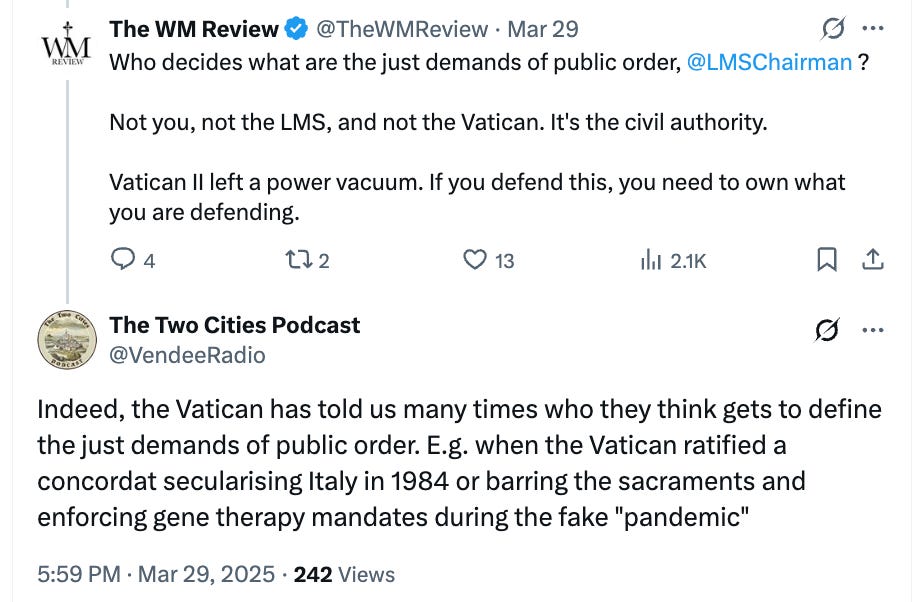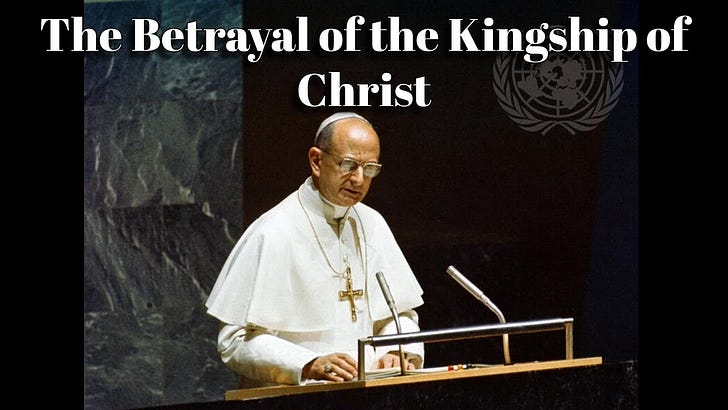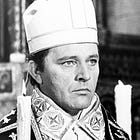Linking Satanism with religious liberty triggered some outrage—here's why
We either accept that liberalism pervades the very air we breathe, or we live in denial.

We either accept that liberalism pervades the very air we breathe, or we live in denial.
Satanists, Religious Liberty, Vatican II
We’ve never lost so many email subscribers from a single article as we did from our piece on Satanism, Vatican II and religious liberty. It was not a lot, but it was noticeable.
The premise of that article was straightforward: following a recent Satanist event in Kansas USA, we argued that Vatican II’s doctrine of religious liberty logically entails the protection of Satanic worship, so long as it is within the civil authority’s conception of “just public order.”
(For the same reasons, this document also subjects the Church’s mission to the same judgments of the civil authority)
Some people found this conclusion disgusting or absurd. We have already addressed why none of the objections stand up (and have expanded the relevant section as more appeared).
But the outrage this idea provoked revealed something deeper than simple disagreement.
First, take a look at some of responses to the idea on Twitter:
Luckily, not everyone agreed. Theo Howard—with whom we recently discussed this topic on his Two Cities Podcast—defended our point about the power vacuum left by Dignitatis Humanae:
Doubling down on the facts
In any case, we are sorry if people are offended by such ideas.
We understand that many are attached to ideas of religious liberty and the teaching of Vatican II—although they shouldn’t try and shoot the messenger.
As for us, we are not going to back down.
In fact, we are going to double down—because it is better to lose readers by telling the truth than to keep them by remaining silent.
Here, then, are the facts:
Vatican II’s doctrine of religious liberty is a rejection of Catholic teaching.
There is no coherent reason to deny that this liberty extends to polytheists, Satanists, or any other false cult; the alleged right pertains to all men, not to the religions themselves
As Dignitatis Humanae specifically refers to the beliefs (among other things) of all men, there are no grounds to say that Satanism is a fake religion (as if the others were not also fake religions) and that its adherents do not have the rights alleged in Dignitatis Humanae.
The doctrine of Dignitatis Humanae is a tacit denial of Christ’s Kingship over society and the duties that civil authorities owe to him—as well as the traditional doctrine of the liberty of the Church
It is rooted not in Catholic theology, but in agnosticism and naturalism—the foundations of the “religion of man”
As such, this Enlightenment imposture is properly described as Promethean—and therefore Luciferian.
As we shall see in greater detail in a future article, Vatican II’s doctrine of religious liberty not only protects Satanism: it is also Luciferian in its very principles.
Luciferianism
Fr Álvaro Calderón’s book on Vatican II is titled: Prometheus: The Religion of Man. In Greek myth, Prometheus was a Titan who took fire from the gods and gave it to mankind. He was dreadfully punished for this, being bound to a rock and having his liver eaten by an eagle every day (the organ regenerating each night). Because of this myth, Prometheus is treated as a heroic benefactor of mankind, and features as such in the literature of the Romantic period.
Satan, specifically under the name of Lucifer, is treated in a similar way. The name “Lucifer” means the bringer of light—the light of knowledge, as well as freedom, equality and fraternity.
Lucifer and Prometheus represent the ideals of the modern world in which we live, and modernism, naturalism, rationalism, freemasonry, and many other such false philosophies all converge on these ideas. Luciferianism might be described as the (apparently) “nice” side of Satanism.
Satan was the first Liberal, and the first advocate of what some like to call “the Revolution.” Like Prometheus, he brings us the knowledge man needs to live—apparently—free from God.
As such, it is not surprising that the worship of this first Liberal is protected, at least in principle, by Vatican II’s doctrine of religious liberty. This doctrine is one fruit of what Cardinal Ratzinger approvingly called “an attempt at an official reconciliation with the new era inaugurated in 1789” (namely, of the French Revolution).1
The “orthodox” phrases in the document, or elsewhere in Vatican II as a whole, change nothing. These phrases are not doctrinal anchors—they are a diversion, existing only to help people swallow the falsehoods buried elsewhere.
This is why Vatican II is a robber council, which cannot have come from the Catholic Church, and must be jettisoned.
These points—the Luciferianism of these modern errors, and the role of “orthodox phrases”— have already been proven by others on several occasions. However, given their importance, we shall be explaining these points again in due course.
(Make sure you are subscribed to the free email list, so as not to miss this.)
But still we must ask, why such hostility from Catholics when confronted with these ideas? One aspect of the answer is as follows.
Two types of men
Broadly speaking, there are two types of people among us.
The first type recognises that we live in a world saturated with naturalism and liberalism—and that he himself is not exempt. When he discovers yet another layer of these errors in his own assumptions, instincts, or beliefs, he rejoices. Now more of the rot can be identified, and cut out. The work of restoration advances.
The second type remains in denial. He cannot admit that his cherished views (or the ideals of his nation) might be the fruit of liberalism or naturalism; nor can he admit how far he has been shaped by these philosophies. When this possibility is raised, the persona he has constructed—that of the stable, moderate conservative—is threatened. To defend this persona, he rushes to justify the error, deny its implications, or shoot the messenger. Some of these men want or already have a seat at the Vatican II establishment’s table, and are heavily invested in making sure that everything “checks out.”
The idea that the Council could have taught a doctrine that protects the public worship of Satan is simply too much for the persona to bear.
Many of us have acted in this second way at one time or another. And not all defenders of Vatican II fall into this second camp: some are honest men who truly believe these strange doctrines can be squared with the Catholic faith through the various far-fetched solutions offered. You can usually tell who these men are: they don’t lash out or posture. They disagree, state their reasons, and maintain charity.
But this division is, most likely, the reason for triggered outrage over this topic.
This danger of ideological thinking is very real, and ever present to all of us.
May we all be preserved from it.
Read next:
See also: Religious Liberty – The Failed Attempts To Defend Vatican II
HELP KEEP THE WM REVIEW ONLINE!
As we expand The WM Review we would like to keep providing free articles for everyone.
Our work takes a lot of time and effort to produce. If you have benefitted from it please do consider supporting us financially.
A subscription from you helps ensure that we can keep writing and sharing free material for all. Plus, you will get access to our exclusive members-only material.
(We make our members-only material freely available to clergy, priests and seminarians upon request. Please subscribe and reply to the email if this applies to you.)
Subscribe now to make sure you always receive our material. Thank you!
Follow on Twitter, YouTube and Telegram:
Joseph Ratzinger, Principles of Catholic Theology, pp 381-2, 391. Ignatius Press, San Francisco CA, 1989.











The ‘outrage’ is because you’re Directly Over the Target. They’re both the same. The spontaneous outrage is equal to the possessed having to see the Crucifix and be splattered with Holy Water. Those ‘triggered’ have no standing to pose Pharisee-like Gotcha Questions.
The article on V2 religious liberty is very thorough and well thought out..... and true. The effects of the religious liberty / [false] ecumenical efforts of V2 are far and wide. Most V2 Catholics believe you can get to Heaven via some other church, and that all nice dogs go the Heaven. Yay. And these folks get angry if you take away their rose colored glasses.